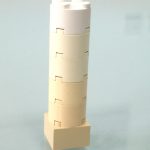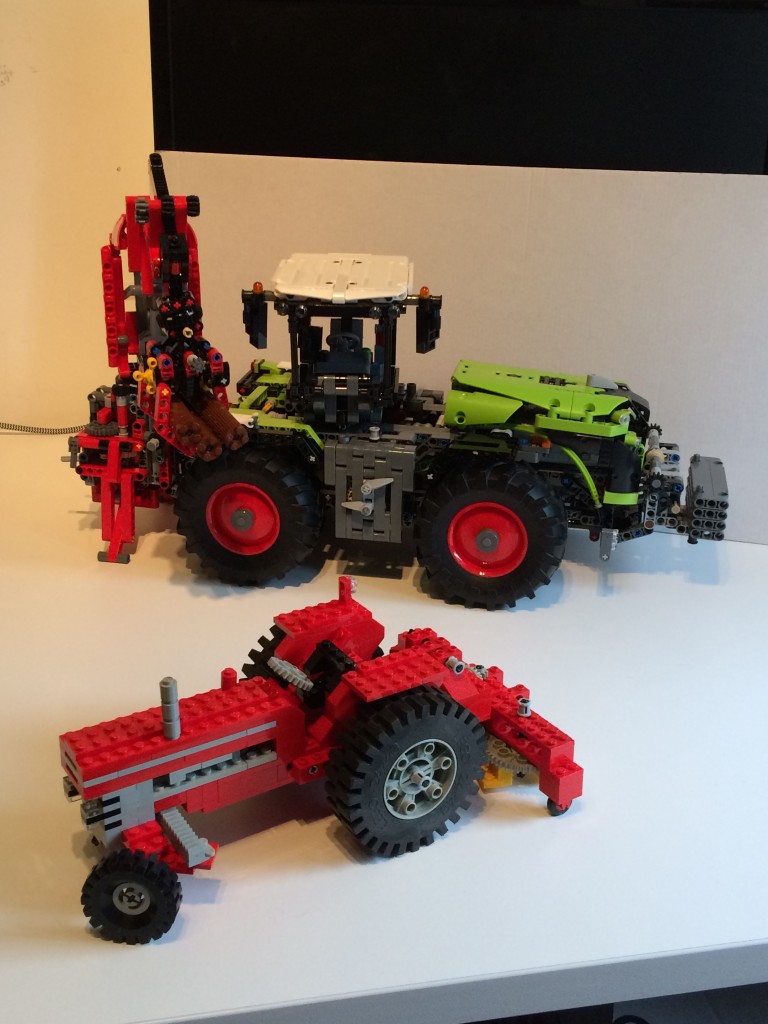
This gallery contains 1 photo.
At the top: a new White and at the bottom a new Tan (square). The bricks in the middle are yellowed with age. There is no part that would fill the yellow area.

This gallery contains 1 photo.
At the top: a new White and at the bottom a new Tan (square). The bricks in the middle are yellowed with age. There is no part that would fill the yellow area.
 40 years ago, LEGO introduced “Technic”, a range of sets aimed at older children. The red tractor (set 851, introduced 1977) was one of the first sets in the new Technic range. Most of the bricks are standard LEGO pieces, but the Technic range also introduced axles, gears, and bricks with holes to mount the axles. The tractor featured working steering, and the implement at the back rotates when the tractor is pushed along.
40 years ago, LEGO introduced “Technic”, a range of sets aimed at older children. The red tractor (set 851, introduced 1977) was one of the first sets in the new Technic range. Most of the bricks are standard LEGO pieces, but the Technic range also introduced axles, gears, and bricks with holes to mount the axles. The tractor featured working steering, and the implement at the back rotates when the tractor is pushed along.
There have been about 10 tractors in the Technic range over the years, of various sizes and qualities. In 2016, LEGO released a new model (set 42054), based closely on a real tractor, the Claas Xerion, with a logging crane attachment at the back. This model includes an electric motor to power lift and rotation of the logging attachment, and the rotation of the cab.
The two models embody two separate developments over the last 40 years. Tractors themselves have changed dramatically, in terms of size, power, driver comfort, controls and many other aspects. And LEGO Technic has also changed over that time. The Claas model contains hardly any “traditional” bricks, and instead uses stud-less beams connected with pins and axles for its structure, as seen in most of the current Technic range. This leads to a very solid robust model (unlike early Technic models, which relied a lot on clutch power between the bricks, and were often flimsy).
The instructions for both models are distributed in paper form. The instruction book for the red tractor also includes instructions for four or five alternative attachments for the back. The book for the Claas only includes the instructions for the tractor and the logging attachment: plans for an alternative attachment are available on the Internet. The World Wide Web didn’t exist when LEGO introduced the Technic range.
I enjoyed rebuilding 851 for nostalgia. The build is somewhat frustrating in places because it is flimsy. The instructions are also less detailed : kids had to do more thinking and counting on their own back then. I enjoyed building 42054 for different reasons: it is quite challenging to assemble, like a 3D jigsaw puzzle, and quite robust from the start. It felt like half the instructions concerned the construction of one sort of frame or another from smaller elements. Then it all comes together at the end, and there are a number of “aha” moments when one realises what certain features are for. Especially that rising rotating cab. The guy who designed that is a genius.
I visited my local LEGO Store (Watford, UK) yesterday and filled up three Pick-a-Brick cups. I posted photos on my Flickr to show what part are available.
Here is the low-down on my haul:
 With care, it is possible to get loads of pieces in each cup. Here you can see how I put larger plates (the red ones) in later, around the edge, after filling the bottom with smaller parts. Those googly eyes are irresistible!
With care, it is possible to get loads of pieces in each cup. Here you can see how I put larger plates (the red ones) in later, around the edge, after filling the bottom with smaller parts. Those googly eyes are irresistible!
I filled a small cup too. Around the edge of the cup are tan 2×6 plates partially connected. In the middle is a block of 2×4 bricks. Into the gaps, I pushed a whole bunch of small black wedge-shaped pieces (these parts). On top of these, I threw in loads of 2×4 plates. I could have spent another hour stacking them, but I wasn’t quite that patient.
The third cup is similarly stacked full of small parts. Back at home, I use these sorting trays to sort out the parts. These are from Really Useful Boxes, and they have sufficient curve at the bottom and sides of each compartment that it is easy to pick up the parts.
In the UK, large Lego PaB cups are £11.99 and small ones are £6.99. If you re-use a cup, you get a discount (75p off the large cups, 50p off the small cups). I also had a voucher and some Lego VIP points, so I got all three cups for next to nothing.
Summary
Cup 1: 244g incl. cup. 189g excl. cup 183 pieces.
Cup 2: 248g incl. cup. 193g excl.cup. 581 pieces.
Cup 3: 450g incl. cup. 367g excl. cup. 761 pieces